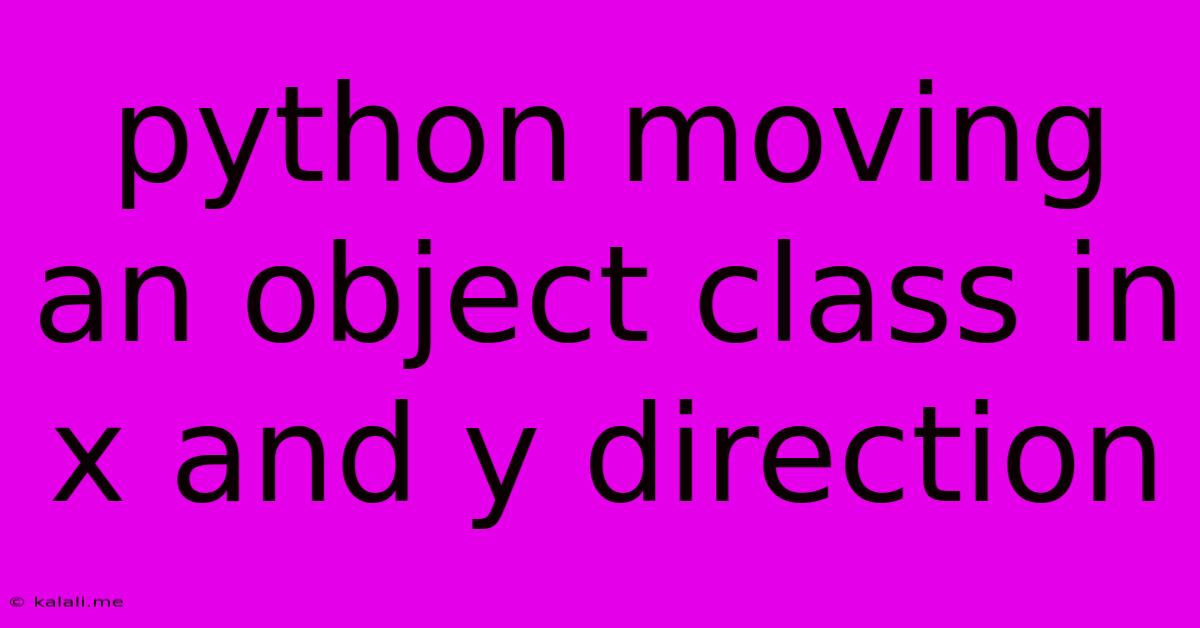Python Moving An Object Class In X And Y Direction
Kalali
Jun 07, 2025 · 2 min read

Table of Contents
Moving Objects in Python: A Class-Based Approach
This article explores how to create a Python class representing a movable object and control its position in both the x and y directions. We'll cover fundamental concepts and provide practical examples suitable for beginners and intermediate programmers. Understanding object-oriented programming (OOP) principles is beneficial, but not strictly required to follow along. This technique is applicable to various projects, from simple game development to more complex simulations.
Defining the Movable Object Class
The core of our solution lies in a well-defined class. This class will encapsulate the object's properties (like position) and methods (like movement). Let's create a MovableObject class:
class MovableObject:
def __init__(self, x, y):
self.x = x
self.y = y
def move(self, dx, dy):
self.x += dx
self.y += dy
def get_position(self):
return self.x, self.y
This class uses __init__ to initialize the object's x and y coordinates. The move method updates the position by adding dx and dy to the current x and y values respectively. get_position returns the current coordinates as a tuple. dx and dy represent changes in the x and y directions.
Using the Movable Object Class
Now let's see how to utilize this class:
# Create a MovableObject instance
my_object = MovableObject(10, 5)
# Get the initial position
print(f"Initial position: {my_object.get_position()}") # Output: Initial position: (10, 5)
# Move the object
my_object.move(3, -2)
# Get the updated position
print(f"Position after movement: {my_object.get_position()}") # Output: Position after movement: (13, 3)
#Further movement examples demonstrating flexibility
my_object.move(-5, 7)
print(f"Position after further movement: {my_object.get_position()}") # Output: Position after further movement: (8,10)
This demonstrates the basic functionality. You can easily extend this class to include additional features, such as:
Expanding the Functionality: Adding Features
-
Speed and Direction: Introduce
speedanddirectionattributes to simulate movement with a velocity vector. This allows for more realistic object movement. -
Boundaries: Implement boundary checks to prevent the object from moving beyond a defined area. This is crucial in game development or simulations where objects should stay within a certain region.
-
Collision Detection: Add methods to detect collisions with other objects. This requires another class representing other objects and a collision detection algorithm.
-
Graphical Representation: Integrate with a graphics library like Pygame to visually represent the object's movement on the screen. This would transform the code into a basic animation.
Conclusion
This class-based approach provides a structured and flexible way to handle moving objects in Python. By extending the MovableObject class with additional attributes and methods, you can create more complex and realistic simulations or game mechanics. Remember to carefully consider the specific requirements of your project when designing and implementing these additional features. This foundational understanding will enable you to build increasingly sophisticated applications.
Latest Posts
Latest Posts
-
Can You Put A Teflon Pan In The Oven
Jun 07, 2025
-
Word For Beginners Whith Expensive Stuff
Jun 07, 2025
-
Screen Flashes Black Coming In And Out Of Water Minecraft
Jun 07, 2025
-
Spade Bits Drill Hole In The Desk
Jun 07, 2025
-
Contact Us When Your Footer Has Your Information
Jun 07, 2025
Related Post
Thank you for visiting our website which covers about Python Moving An Object Class In X And Y Direction . We hope the information provided has been useful to you. Feel free to contact us if you have any questions or need further assistance. See you next time and don't miss to bookmark.